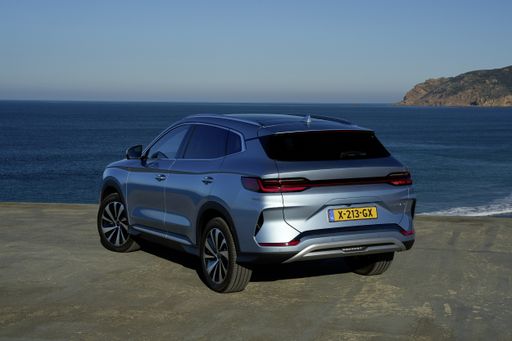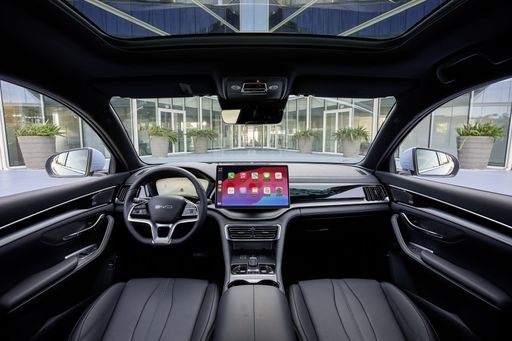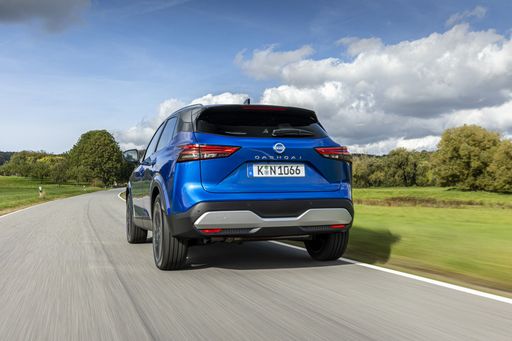In the ever-evolving automotive market, the competition between electric and hybrid vehicles is fiercer than ever. In this article, we will delve into the technical intricacies and innovative features of two remarkable SUVs: the BYD Seal U and the Nissan Qashqai. As both models aim to capture the attention of eco-conscious consumers, let's scrutinize what they bring to the table.
BYD Seal U vs Nissan Qashqai – Performance, range & efficiency compared
Everyday use, family trips or long-distance drives – here’s where the differences show.
Discover whether BYD Seal U or Nissan Qashqai fits your lifestyle better.
Exterior Design and Dimensions
The BYD Seal U boasts a striking design that merges aesthetics with functionality. Measuring between 4775 mm and 4785 mm in length, 1890 mm in width, and standing at 1668 mm to 1670 mm in height, it projects a robust stature. Its five-door design and spacious trunk capacity of up to 552 liters make it practical for families on the go.
In contrast, the Nissan Qashqai, slightly smaller at 4425 mm in length, 1835 mm in width, and 1625 mm in height, maintains the SUV character with a sleek and modern profile. Its trunk space is decent, with a capacity ranging from 479 to 504 liters, making it suitable for everyday tasks.
Powertrains and Performance
The BYD Seal U offers a versatile choice of powertrains including plug-in hybrid and electric options. It produces an impressive 218 to 324 HP, with a torque range of 300 to 550 Nm. This power translates to quick acceleration from 0-100 km/h in as little as 5.9 seconds. The electric range extends up to 500 km, catering to users looking for a long-distance, eco-friendly drive.
The Nissan Qashqai, on the other hand, features petrol MHEV and full hybrid engines, delivering between 140 to 190 HP with torque figures up to 330 Nm. Its acceleration from 0-100 km/h is capped at 7.9 seconds, indicating strong performance in urban settings while achieving fuel efficiency between 5.1 to 6.8 L/100km.
Fuel Efficiency and Emissions
When it comes to fuel consumption and emissions, the BYD Seal U leads the charge with its electric-oriented design. With energy consumption rated at just 19.9 to 20.5 kWh/100 km and CO2 emissions as low as 0 g/km for the fully electric variant, it positions itself as a strong candidate for environmentally conscious buyers.
Conversely, the Qashqai's petrol engines offer a different but competitive side of fuel efficiency, with consumption ratings between 5.1 to 6.8 L/100 km and CO2 emissions ranging from 116 to 154 g/km. Although the Qashqai's emissions are higher compared to the Seal U, it presents a balance of performance and practicality that many consumers appreciate.
Interior and Technology Innovations
Inside, the BYD Seal U is designed for comfort and technology. With ample seating for five passengers, it focuses on a user-friendly interface that includes a large infotainment display, premium materials, and various smart features that enhance the driving experience. Innovations such as advanced driver-assistance systems are also part of its offering, providing both safety and convenience.
The Nissan Qashqai also does not disappoint, featuring a well-crafted cabin loaded with tech-savvy options, including a user-friendly infotainment system that integrates seamlessly with smartphones. Enhanced safety features such as Nissan's ProPILOT assist further enrich the driving experience, showcasing the brand's commitment to innovation.
Conclusion
Ultimately, the choice between the BYD Seal U and the Nissan Qashqai depends on individual preferences and driving needs. The Seal U excels in offering electric driving solutions with remarkable performance and eco-friendliness, while the Qashqai remains a strong contender with its hybrid options and practicality. Both vehicles illustrate the automotive industry's shift towards sustainability without compromising on performance. As such, consumers will greatly benefit from the advancements and choices presented by these two innovative models.
Here’s where it gets real: The technical differences in detail
Costs and Efficiency:
Looking at overall running costs, both models reveal some interesting differences in everyday economy.
Nissan Qashqai has a somewhat advantage in terms of price – it starts at 29600 £, while the BYD Seal U costs 34300 £. That’s a price difference of around 4672 £.
Fuel consumption also shows a difference: BYD Seal U manages with 0.40 L and is therefore decisively more efficient than the Nissan Qashqai with 4.50 L. The difference is about 4.10 L per 100 km.
Engine and Performance:
Power, torque and acceleration say a lot about how a car feels on the road. This is where you see which model delivers more driving dynamics.
When it comes to engine power, the BYD Seal U has a clearly perceptible edge – offering 324 HP compared to 205 HP. That’s roughly 119 HP more horsepower.
In acceleration from 0 to 100 km/h, the BYD Seal U is clearly perceptible quicker – completing the sprint in 5.90 s, while the Nissan Qashqai takes 7.60 s. That’s about 1.70 s faster.
In terms of top speed, the Nissan Qashqai performs slightly better – reaching 206 km/h, while the BYD Seal U tops out at 180 km/h. The difference is around 26 km/h.
There’s also a difference in torque: BYD Seal U pulls distinct stronger with 550 Nm compared to 330 Nm. That’s about 220 Nm difference.
Space and Everyday Use:
Cabin size, boot volume and payload all play a role in everyday practicality. Here, comfort and flexibility make the difference.
Both vehicles offer seating for 5 people.
In curb weight, Nissan Qashqai is evident lighter – 1420 kg compared to 1940 kg. The difference is around 520 kg.
In terms of boot space, the BYD Seal U offers barely noticeable more room – 552 L compared to 504 L. That’s a difference of about 48 L.
In maximum load capacity, the BYD Seal U performs hardly perceptible better – up to 1465 L, which is about 18 L more than the Nissan Qashqai.
When it comes to payload, Nissan Qashqai noticeable takes the win – 520 kg compared to 410 kg. That’s a difference of about 110 kg.
Who comes out on top?
Overall, the BYD Seal U shows itself to be wins the duel decisively and secures the title of DriveDuel Champion.
It convinces with the more balanced overall package and proves to be the more versatile choice for everyday use.
 @ BYD Auto / BYD Global Media
@ BYD Auto / BYD Global Media
BYD Seal U
BYD Seal U
The BYD Seal U pairs a sleek fastback silhouette with a surprisingly roomy, tech-rich cabin, giving electric chic without the showroom pretension. It's a smart pick for buyers after confident handling, sensible practicality and standout value — all wrapped up with a cheeky grin when you put your foot down.
details @ BYD Auto / BYD Global Media
@ BYD Auto / BYD Global Media
 @ BYD Auto / BYD Global Media
@ BYD Auto / BYD Global Media
 @ BYD Auto / BYD Global Media
@ BYD Auto / BYD Global Media
Nissan Qashqai
The Nissan Qashqai blends practical, family-friendly packaging with SUV styling that refuses to shout, making it a sensible and dependable choice for everyday life. It’s comfortable to live with, economical on the road, and neatly equipped enough to feel modern without ever feeling precious — perfect if you want crossover versatility without the drama.
details @ Nissan Motor Corporation
@ Nissan Motor Corporation
 @ Nissan Motor Corporation
@ Nissan Motor Corporation
 @ Nissan Motor Corporation
@ Nissan Motor Corporation
 @ Nissan Motor Corporation
@ Nissan Motor Corporation
 @ Nissan Motor Corporation
@ Nissan Motor Corporation
 @ BYD Auto / BYD Global Media
@ BYD Auto / BYD Global Media
|
 @ Nissan Motor Corporation
@ Nissan Motor Corporation
|
|
|
|
Costs and Consumption |
|
|---|---|
|
Price
34300 - 39800 £
|
Price
29600 - 39900 £
|
|
Consumption L/100km
0.4 - 1.2 L
|
Consumption L/100km
4.5 - 6.8 L
|
|
Consumption kWh/100km
19.9 - 20.5 kWh
|
Consumption kWh/100km
-
|
|
Electric Range
70 - 500 km
|
Electric Range
-
|
|
Battery Capacity
-
|
Battery Capacity
-
|
|
co2
0 - 26 g/km
|
co2
102 - 154 g/km
|
|
Fuel tank capacity
60 L
|
Fuel tank capacity
55 L
|
Dimensions and Body |
|
|---|---|
|
Body Type
SUV
|
Body Type
SUV
|
|
Seats
5
|
Seats
5
|
|
Doors
5
|
Doors
5
|
|
Curb weight
1940 - 2147 kg
|
Curb weight
1420 - 1665 kg
|
|
Trunk capacity
425 - 552 L
|
Trunk capacity
479 - 504 L
|
|
Length
4775 - 4785 mm
|
Length
4425 mm
|
|
Width
1890 mm
|
Width
1835 mm
|
|
Height
1668 - 1670 mm
|
Height
1625 mm
|
|
Max trunk capacity
1440 - 1465 L
|
Max trunk capacity
1422 - 1447 L
|
|
Payload
410 kg
|
Payload
466 - 520 kg
|
Engine and Performance |
|
|---|---|
|
Engine Type
Plugin Hybrid, Electric
|
Engine Type
Petrol MHEV, Full Hybrid
|
|
Transmission
Automatic
|
Transmission
Manuel, Automatic
|
|
Transmission Detail
CVT, Reduction Gearbox
|
Transmission Detail
Manual Gearbox, CVT, Reduction Gearbox
|
|
Drive Type
Front-Wheel Drive, All-Wheel Drive
|
Drive Type
Front-Wheel Drive, All-Wheel Drive
|
|
Power HP
218 - 324 HP
|
Power HP
140 - 205 HP
|
|
Acceleration 0-100km/h
5.9 - 9.6 s
|
Acceleration 0-100km/h
7.6 - 10.2 s
|
|
Max Speed
170 - 180 km/h
|
Max Speed
170 - 206 km/h
|
|
Torque
300 - 550 Nm
|
Torque
240 - 330 Nm
|
|
Number of Cylinders
4
|
Number of Cylinders
3 - 4
|
|
Power kW
160 - 238 kW
|
Power kW
103 - 151 kW
|
|
Engine capacity
1497 - 1498 cm3
|
Engine capacity
1332 - 1498 cm3
|
General |
|
|---|---|
|
Model Year
2024
|
Model Year
2025
|
|
CO2 Efficiency Class
B, A
|
CO2 Efficiency Class
E, C
|
|
Brand
BYD
|
Brand
Nissan
|
What drive types are available for the BYD Seal U?
The BYD Seal U is available as Front-Wheel Drive or All-Wheel Drive.
The prices and data displayed are estimates based on German list prices and may vary by country. This information is not legally binding.
